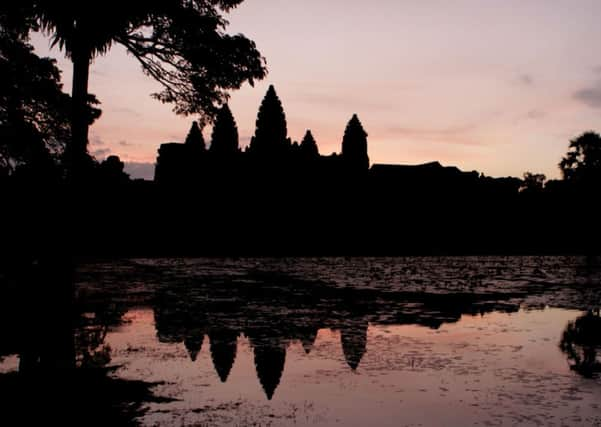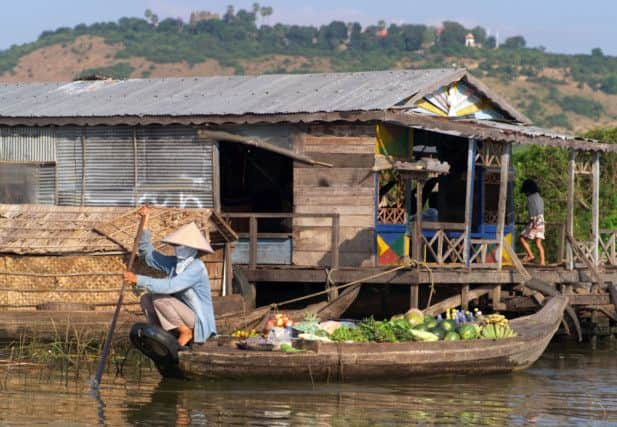Cambodia: Of temples and trainers


The temperature is rising sharply with the morning sun and my legs are feeling heavier than I would like. It is still just 7am and I am beginning to wonder if I will have the energy and strength to pull myself round the last six miles to get to the finish line of this half marathon course.
But with every corner I turn, the views become ever more spectacular and the lines of cheering youngsters on the roadside grow longer, inspiring me to keep going.
Advertisement
Hide AdAdvertisement
Hide AdBy the time the race is almost over, the sun is high in the sky and I am thankful to reach the end, but proud of my achievement. The Angkor Wat Half Marathon has been going for 17 years, with the next race scheduled for December 6, this year.


For a handful of elite runners their time is crucial, but for the vast majority, running around the 900-year-old Unesco World Heritage Site – whose temples rise like crowns from the majestic Cambodian rainforest – is a privilege.
The flat course takes competitors along well-maintained roads past some of the city’s most iconic sites, including the Angkor Wat Temple, Bayon Temple and Ta Keo Temple. Able-bodied runners are also given a poignant reminder of the horrors of Cambodia’s past, as dozens of wheelchair users take on the course, as well as competitors with artificial arms or legs racing over a 10km distance. There is even a 3km family race so children can get involved.
Money raised from the run is used to create prosthetic limbs, offer support to victims and to appeal for the abolishment of anti-personnel mines, which still claim multiple lives in Cambodia every year.
Advertisement
Hide AdAdvertisement
Hide AdFor many people, of course, the idea of running for miles and miles in the tropics is utter madness, and most visitors to Cambodia’s most famous archaeological park prefer to explore the site at a more leisurely pace.
After a day on your feet, La Residence d’Angkor is the perfect place to rest or reinvigorate your weary muscles.
I’m lucky enough to stay at the Orient Express hotel, which is in the heart of Siem Reap, just a five-minute walk from the famous Pub Street and market. It’s an oasis of calm amid the bustling town. The swimming pool is tiled with unique handpainted mosaics and is surrounded by lush vegetation, while the Kea Kong spa offers massages using ancient Cambodian techniques.
I head to the upstairs Martini Lounge, with its open sides and luxurious chairs, for a well-earned cocktail, followed by a traditional Cambodian dinner in the hotel’s restaurant.
Advertisement
Hide AdAdvertisement
Hide AdThe following morning, I wake up early to watch the sunrise behind the iconic Angkor Wat Temple and the reflection of the changing colours around the temple’s shimmering pool.
Wandering around Angkor Wat feels like you are discovering it for the first time, and with structures nicknamed Tomb Raider Temple (Ta Prohm), it’s easy to lose yourself in a fantasy world.
To explore further afield – but still under one’s own steam – it’s best to get around on two wheels.
Bicycles are everywhere in Cambodia, and guided bike tours are a great way to get out of Siem Reap and into the countryside to find less-trodden places.
Advertisement
Hide AdAdvertisement
Hide AdAfter about 45 minutes on the road, passing overloaded tuk tuks, wandering oxen and streetside shacks, I turn off-road onto a dirt track. I wind my way through the undergrowth, riding over small streams and dodging dangling branches until I reach my destination, the 900-year-old Banteay Thom Temple.
Now nestled in the consuming jungle, the structure was built by Jayavarman VII, the king of the Khmer Empire, at the end of the 12th-century as a dedication to Buddhism. Once populated by monks, the isolated temple is now overgrown but it retains an atmospheric calm.
For an altogether different perspective on Cambodia’s magnificent rainforest, the Flight of the Gibbon adventure offers thrill-seekers the chance to zip-line high above the canopy.
After a few leaps of faith from moderate heights, I find myself 80 metres from the ground, about to launch myself along a high wire 400 metres long. The rush is unforgettable.
Advertisement
Hide AdAdvertisement
Hide AdFor all its thrills, adventures and fun, Cambodia has a well-documented dark and haunting past, and the friendly smiles on the faces of the country’s many children belie the unspeakable horrors endured by their parents and grandparents.
A guide I meet tells me the story of his life. In 1975 the Khmer Rouge shot his father dead. His mother sold most of her possessions to pay for bribes to get her young family to a refugee camp near the border with Thailand, where they stayed for 18 years before eventually returning home to Siem Reap. Just four decades ago, the country’s population was being wiped out as men were executed by Khmer soldiers, while millions were left to starve or die of disease.
Now, in an apparent nationwide rebellion against the genocide, the country’s population is booming, and more than a third of the 14 million people in Cambodia are under the age of 15, according to the 2008 census.
Cambodia is progressing fast and tourism is crucial to its long-term success, so why not dust off those trainers and sign up for this year’s Angkor Wat Half Marathon?